Argentine Army
The Argentine Army (Ejército Argentino, EA) is the land armed force branch of the Armed Forces of the Argentine Republic and the senior military service of Argentina. Under the Argentine Constitution, the President of Argentina is the Commander-in-Chief of the Armed Forces, exercising his or her command authority through the Minister of Defense.
| Argentine Army | |
|---|---|
| Ejército Argentino | |
 Seal of the EA. | |
| Founded | May 29, 1810 |
| Country | |
| Branch | Army |
| Size | 70,000 active personnel (2019) |
| Part of | Ministry of Defense |
| Motto(s) | Born with the Fatherland in May 1810 |
| March | Song |
| Anniversaries | Army Day (29 May) |
| Equipment | Equipment of the Argentine Army |
| Engagements | List
|
| Website | argentina.gob.ar/ejercito |
| Commanders | |
| Commander-in-chief | President Alberto Fernández |
| Chief of General Staff | Brigadier general Agustín Humberto Cejas |
| Deputy Chief of General Staff | Divisional-general Héctor Horacio Prechi |
| Insignia | |
| Identification symbol | .svg.png) |
The Army's official foundation date is May 29, 1810 (celebrated in Argentina as the Army Day), four days after the Spanish colonial administration in Buenos Aires was overthrown. The new national army was formed out of several pre-existent colonial militia units and locally manned regiments; most notably the Infantry Regiment "Patricios", which to this date is still an active unit.
As of 2019, the active element of the Argentine Army numbered some 70,000 military personnel.
History
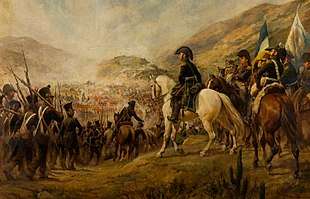
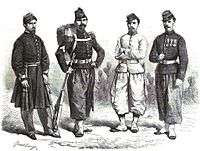
Several armed expeditions were sent to the Upper Peru (now Bolivia), Paraguay, Uruguay and Chile to fight Spanish forces and secure Argentina's newly gained independence. The most famous of these expeditions was the one led by General José de San Martín, who led a 5000-man army across the Andes Mountains to expel the Spaniards from Chile and later from Perú. While the other expeditions failed in their goal of bringing all the dependencies of the former Viceroyalty of the Río de la Plata under the new government in Buenos Aires, they prevented the Spaniards from crushing the rebellion.
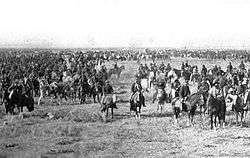
During the civil wars of the first half of the 19th century, the Argentine Army became fractionalized under the leadership of the so-called caudillos ("leaders" or "warlords"), provincial leaders who waged a war against the centralist Buenos Aires administration. However, the Army was briefly re-unified during the war with the Brazilian Empire. (1824–1827).
It was only with the establishment of a Constitution (which explicitly forbade the provinces from maintaining military forces of their own) and a national government recognized by all the provinces that the Army became a single force, absorbing the older provincial militias. The Army went on to fight the War of the Triple Alliance in the 1860s together with Brazil and Uruguay against Paraguay. After that war, the Army became involved in Argentina's Conquista del Desierto ("Conquest of the Desert"): the campaign to occupy Patagonia and root out the natives, who conducted looting raids throughout the country.
1880–1960s
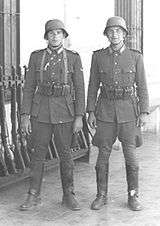
Between 1880 and 1930, the Army sought to become a professional force without active involvement in politics, even though many a political figure -President Julio Argentino Roca, for example- benefitted from a past military career. The Army prevented the fall of the government in a number of Radical-led uprisings. Meanwhile, the military in general and the Army, in particular, contributed to develop Argentina's unsettled southern frontier and its nascent industrial complex.
The main foreign influence during this period was, by and large, the Prussian (and then German) doctrine. Partly because of that, during both World Wars most of the officers supported the Germans, more or less openly, while the Argentine Navy favored the British instead.
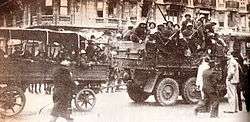
In 1930, a small group of Army forces (not more than 600 troops) deposed President Hipólito Yrigoyen without much response from the rest of the Army and the Navy. This was the beginning of a long history of political intervention by the military. Another coup, in 1943, was responsible for bringing an obscure colonel into the political limelight: Juan Perón.
Even though Perón had the support of the military during his two consecutive terms of office (1946–1952 and 1952–1955), his increasingly repressive government alienated many officers, which finally led to a military uprising which overthrew him in September 1955. Between 1955 and 1973 the Army and the rest of the military became vigilant over the possible re-emergence of Peronism in the political arena, which led to two new coups against elected Presidents in 1962 (deposing Arturo Frondizi) and 1966 (ousting Arturo Illia). Political infighting eroded discipline and cohesion within the army, to the extent that there was armed fighting between contending military units during the early 1960s.
1960s and the military junta
The military government which ruled Argentina between 1966 and 1973 saw the growing activities of groups such as Montoneros and the ERP, and also a very important social movement. During Héctor Cámpora's first months of government, a rather moderate and left-wing Peronist, approximatively 600 social conflicts, strikes and factory occupations had taken place.[1] Following the June 20, 1973 Ezeiza massacre, left and right-wing Peronism broke apart, while the Triple A death squad, organized by José López Rega, closest advisor to María Estela Martínez de Perón, started a campaign of assassinations against left-wing opponents. But Isabel Perón herself was ousted during the March 1976 coup by a military junta.
The new military government, self-named Proceso de Reorganización Nacional, put a stop to the guerrilla's campaigns, but soon it became known that extremely violent methods and severe violations of human rights had taken place, in what the dictatorship called a "Dirty War" — a term refused by jurists during the 1985 Trial of the Juntas. Batallón de Inteligencia 601 (the 601st Intelligence Battalion) became infamous during this period. It was a special military intelligence service set up in the late 1970s, active in the Dirty War and Operation Condor, and disbanded in 2000.[2] Its personnel collected information on and infiltrated guerrilla groups and human rights organisations, and coordinated killings, kidnappings and other abuses. The unit also participated in the training of Nicaraguan Contras with US assistance, including from John Negroponte.
"Annihilation decrees"
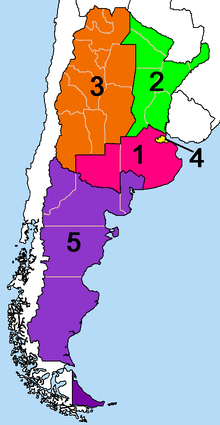
Meanwhile, the Guevarist People's Revolutionary Army (ERP), led by Roberto Santucho and inspired by Che Guevara's foco theory, began a rural insurgency in the province of Tucumán, in the mountainous northwest of Argentina. It started the campaign with no more than 100 men and women of the Marxist ERP guerrilla force and ended with about 300 in the mountains (including reinforcements in the form of the elite Montoneros 65-strong "Compañía de Monte" (Jungle Company) and the ERP's "Decididos de Córdoba" Urban Company),[3] which the Argentine Army managed to defeat, but at a cost.
On 5 January 1975, an Army DHC-6 transport plane was downed near the Monteros mountains, apparently shot down by the Guerrillas.[4] All thirteen on board were killed. The military believe a heavy machine gun had downed the aircraft.[5]
In response, Ítalo Luder, President of the National Assembly who acted as interim President substituting himself to Isabel Perón who was ill for a short period, signed in February 1975 the secret presidential decree 261, which ordered the army to neutralize and/or annihilate the insurgency in Tucumán, the smallest province of Argentina. Operativo Independencia gave power to the Armed Forces to "execute all military operations necessary for the effects of neutralizing or annihilating the action of subversive elements acting in the Province of Tucumán."[6][7] Santucho had declared a 620-mile (1,000 km) "liberated zone" in Tucuman and demanded Soviet-backed protection for its borders as well as proper treatment of captured guerrillas as POWs.[8]
The Argentine Army Fifth Brigade, then consisting of the 19th, 20th and 29th Mountain Infantry Regiments[9] and commanded by Brigadier-General Acdel Vilas received the order to move to Famailla in the foothills of the Monteros mountains on 8 February 1975. While fighting the guerrillas in the jungle, Vilas concentrated on uprooting the ERP support network in the towns, using tactics later adopted nationwide, as well as a civic action campaign. The Argentine security forces used techniques no different from their US and French counterparts in Vietnam.
By July 1975, anti-guerrilla commandos were mounting search-and-destroy missions in the mountains. Army special forces discovered Santucho's base camp in August, then raided the ERP urban headquarters in September. Most of the Compañia de Monte's general staff was killed in October and was dispersed by the end of the year.
The leadership of the rural guerrilla force was mostly eradicated and many of the ERP guerrillas and civilian sympathizers in Tucumán were either killed or forcefully disappeared. Efforts to restrain the rural guerrilla activity to Tucumán, however, remained unsuccessful despite the use of 24 recently arrived US-made Bell UH-1H Huey troop-transport helicopters. In early October, the 5th Brigade suffered a major blow at the hands of the Montoneros, when more than one hundred, and possibly several hundred [10] Montoneros and supporters were involved in the Operation Primicia, the most elaborate operation of the "Dirty War", which involved hijacking a civilian airliner, taking over the provincial airport, attacking the 29th Infantry Regiment (which had retired to barracks in Formosa province) and capturing its cache of arms, and finally escaping by air. Once the operation was over, they escaped towards a remote area in Santa Fe province. The aircraft, a Boeing 737, eventually landed on a crop field not far from the city of Rafaela.
In the aftermath, twelve soldiers and two policemen[11] were killed and several wounded. The sophistication of the operation, and the getaway cars and safehouses they used to escape from the crash-landing site, suggest several hundred guerrillas and their supporters were involved.[12] The Argentine security forces admitted to 43 army troops killed in action in Tucuman, although this figure does not take into account police and Gendarmerie troops, and the soldiers who died defending their barracks in Formosa province on 5 October 1975. By December 1975, the Argentine military could, with some justification claim that it was winning the 'Dirty War', but it was dismayed to find no evidence of overall victory.
On 23 December 1975, several hundred ERP fighters[13] with the help of hundreds of underground supporters, staged an all-out battle with the 601st Arsenal Battalion nine miles (14 km) from Buenos Aires and occupied four local police stations and a regimental headquarters.[14] 63 guerrillas,[15] seven army troops and three policemen were killed.[16] In addition 20 civilians were killed in the crossfire. Many of the civilian deaths occurred when the guerrillas and supporting militants burned 15 city buses[17] near the arsenal to hamper military reinforcements. This development was to have far-reaching ramifications. On 30 December 1975, urban guerrillas exploded a bomb inside the Army's headquarters in Buenos Aires, injuring at least six soldiers.[18]
The Montoneros movement successfully utilized divers in underwater infiltrations and blew the pier where the Argentine destroyer ARA Santísima Trinidad was being built, on 22 August 1975. The ship was effectively immobilized for several years.
French cooperation
French journalist Marie-Monique Robin has found in the archives of the Quai d'Orsay, the French Minister of Foreign Affairs, the original document proving that a 1959 agreement between Paris and Buenos Aires instaured a "permanent French military mission," formed of veterans who had fought in the Algerian War, and which was located in the offices of the chief of staff of the Argentine Army. She showed how Valéry Giscard d'Estaing's government secretly collaborated with Jorge Rafael Videla's junta in Argentina and with Augusto Pinochet's regime in Chile.[19]
Green deputies Noël Mamère, Martine Billard and Yves Cochet deposed on September 10, 2003 a request for the constitution of a Parliamentary Commission on the "role of France in the support of military regimes in Latin America from 1973 to 1984" before the Foreign Affairs Commission of the National Assembly, presided by Edouard Balladur. Apart from Le Monde, newspapers remained silent about this request.[20] However, deputy Roland Blum, in charge of the Commission, refused to hear Marie-Monique Robin, and published in December 2003 a 12 pages report qualified by Robin as the summum of bad faith. It claimed that no agreement had been signed, despite the agreement found by Robin in the Quai d'Orsay[21][22]
When Minister of Foreign Affairs Dominique de Villepin traveled to Chile in February 2004, he claimed that no cooperation between France and the military regimes had occurred.[23]
Falklands war
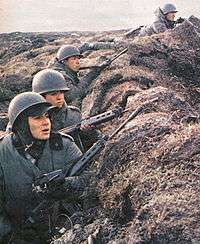
On 2 April 1982, the Argentine Army contributed forces to Operation Rosario, the 1982 invasion of the Falkland Islands, and the occupation that followed. Army forces also opposed the amphibious landing in San Carlos Water on 21 May, and fought the British at Goose Green, Mount Kent, and the battles around Port Stanley that lead to the ceasefire of 14 June followed by the surrender of the Argentine troops.[24]
Defence of the islands
At 04:40 hours on May 1, An Avro 698 Vulcan B.2 bomber dropped 21 1000 pound bombs on the airport runway of Port Stanley, taking the Argentine anti-aircraft defense by surprise. From that moment, they entered into a state of alert. The runway suffered a hole twenty meters in diameter, however, the aircraft could continue operating. The Royal Navy had divided its naval forces into two task groups; one, led by the aircraft carrier HMS Invincible (R05), located north of East Falkland/Soledad Island, 130 kilometers from Puerto Argentino; the other, led by the aircraft carrier HMS Hermes, was located northeast, 93 kilometers from the coast. From the Hermes departed the Harrier GR.3 attack aircraft that unleashed several attacks on the Argentine forces. At 08:25 the Argentine radars reported new air attacks. Then the Argentine anti-aircraft defense was prepared, with guns Oerlikon GDF-002 of 35 millimeters and Skyguard systems, endowment of the Group of Artillery of Antiaircraft Defense 601 (GADA 601). Towards 08:30 hours, a violent battle took place between the Argentine gunners and the British aviators. The British dropped 450 kilograms bombs, the Argentine antiaircraft artillery brought down two Harrier, four were damaged and moved away from the area and a third Harrier was shot down by a Cat missile from the Argentine Navy. After that, the British did not return to attack flying at low altitude, losing effectiveness.[25]
The situation at the Military Air Base (Spanish: Base Aérea Militar, BAM) "Cóndor" was very different; the Darwin airfield housed a squadron of FMA IA 58 Pucará attack aircraft and did not have enough anti-aircraft defenses; it lacked shelters, fuel depots and masking zones. Three British Aerospace Sea Harrier FRS.1 destroyed the planes on the runway, causing eight deaths and nine serious injuries. The anti-aircraft defense could not react because they had been informed that the Pucara would be evacuated from the base to Bourbon Island, so they had to be vigilant from 08:25 to not shoot down their own aircraft. When the British air attack took place, believing that it was about the Argentine planes, they did not open fire.[25]
The troops of the 25th Infantry Regiment (Spanish: RI 25) deployed in the Frecynet peninsula to provide protection to the BAM "Malvinas" were subjected to intense naval gunfire, and must remain in their shelters. Around 18:00 hours, an Argentine mortar fire of 81 millimeters supported by guns from 3rd Artillery Group thwarted a helicopter landing of British troops.[25]
San Carlos Combat
At 08:10 hours on May 21, the Canberra troop transport entered the channel of Puerto de San Carlos, the landing had been preceded by three hours of intense naval gunfire that destroyed the land. While the British massively disembarked troops and equipment, they were observed by soldiers led by First Lieutenant Carlos Daniel Esteban of Company "C" of the 25th Infantry Regiment. At 08:20 hours, several boats guarded from the air by numerous helicopters put to the first Englishmen on the mainland. The British infantry advanced towards the town of San Carlos. First Lieutenant Esteban informed Puerto Argentino radially of what was happening, and was ordered to move eastwards, so that they would not be surrounded by a helicopter descent. At 08:40 hours, while two British companies arrived at the town and a Sea King helicopter tried to alight with its cargo of soldiers, Esteban and his 42 men attacked, they spurred the helicopter which went away engulfed in flames and fell into the sea. The British infantry opened fire with mortars and machine guns on the positions of the 25th Regiment, while a Gazelle helicopter rushed on the Argentines, ready to fire their rockets. But again the curtain of fire spread by the Combat Team "Güemes" was lethal. This second machine also rushed to the waters. A third Gazelle launched the attack suffered the same fate. The Argentine soldiers moved, avoiding the search for a fourth Gazelle to which they again attacked with their portable weapons. This last machine walked away engulfed in flames and smoke.[26]
Esteban and his troop waited for two hours for the withdrawal of "Gato" (the Support Section of Second Lieutenant Reyes) from height 234. The "Güemes" combat team retired without suffering any casualties, leaving behind three destroyed Gazelles, one King seriously damaged and probably a score of enemy casualties. These 42 men returned on foot to Puerto Argentino, arriving on May 26. This courageous action and that of Second Lieutenant Reyes, who opened fire with his 105 mm guns on the British fleet, turned out to be the only terrestrial opposition that was made to the English landing in San Carlos.[26]
Darwin – Goose Green Combat
When the British forces consolidated his beachhead in Port San Carlos he set out to start the march towards Stanley; but to achieve this, it had to face the "Mercedes" Grouping (642 troops), composed of the 12th and 25th Infantry Regiments, the 601th Anti-aircraft Defense Artillery Group, a section of the 8th Infantry Regiment, the 9th Engineering Company, and the 4th Airborne Artillery Group.
On May 23, an attack by British aircraft destroyed two Puma helicopters and an Agusta A109 helicopter; then, on the afternoon of the 27th, there were English air strikes on the positions of Company "A" and Battery "A" of the Airborne Artillery Group 4. At 22:50 hours on May 28, a naval gunfire was unleashed. on the "A" Company, and during the early morning of the 29th, the English Infantry advanced on the positions of the "A" Company, beating it with intense mortar fire and machine guns. The center of gravity of the British attack came from Sussex Camilla Creek. The Argentineans counterattacked, with their mortars of 81 and 120 millimeters they executed fire on the British rearguard, and fighting furiously, they began their retreat. The western sector had given way but, fighting hand to hand and at close distances, it was possible to restore the situation and rebuild the front. After the ammunition was exhausted, the Support Section withdrew, abandoning the heavy weapons. At 06:00 hours, the massive volume of English fire was reducing the Argentine defenses. Lieutenant Roberto Estévez occupied a position in the Prairie Goose School and executed a counterattack at Boca House that caused many British casualties, thus achieving the re-composition of the first line of defense. During this hard fight, he lost his life. They continued directing the artillery fire, through the communications team, in the first instance Corporal Mario Castro, and after his death, the soldier Fabricio Edgar Carrascul, who finally also fell dead.[27]
At 08:30 hours the Company "A" had experienced many casualties and the survivors withdrew to the population. When retiring, the second lieutenant Marcelo Raul Colombo made an attack with two mortars of 81 millimeters, beating the North of the positions of the Company "To" to allow the retreat of those cash. Meanwhile, doctors at the Army and Air Force roamed the sectors carrying out the first aid to the wounded and deriving the most serious aid stations at Goose Green. At 09:30 hours, the enemy stopped their attack and retreated to the North. At that time, the defensive position of the Task Force "Mercedes" was reinforced and two helicopters of the Army Aviation landed to evacuate the wounded despite the constant enemy fire. At 10:30 pm on May 28, the effective charge of second lieutenant Juan José Gómez Centurión vigorously fought back and managed to reach heights located two kilometers north of Goose Green. At 12:30, the British forces launched a massive final attack. His strong field artillery fire and mortars punished the positions of the 8th Infantry Regiment, the "A" Company and members of the Darwin Services Company. The situation became untenable for the Argentinians who had fought to the limit of their logistical possibilities. At 9:30 p.m. on May 29, the head of the Task Force "Mercedes" reported that the situation could no longer be sustained. At 11:00 hours on May 30 there was a ceasefire and the end of the largest land battle of the Falklands campaign.[27]
Blasting the Fitzroy Bridge
The Fitzroy Bridge was located on a river southwest of Port Stanley and it was a one-hundred-meter-long construction, with a wooden walkway and thick concrete piles. It crossed the deep estuary and communicated the town of Fitzroy, where there was a rural establishment, with Port Stanely. Its strategic importance was fundamental: through the watercourse, ships could arrive to disembark troops, shortening the road to Port Stanley.[28] The troops that had been guarding it had retreated without being able to blow up the charges that had been installed on the bridge before, given that due to the inclement weather their wicks were wet and failed. First Lieutenant Horacio Dario Blanco, belonging to the 601th Combat Engineer Company, then received the mission, so with two non-commissioned officers and several soldiers prepared the weapons and loaded the only available explosive 40 kg of TNT. The explosive, as a fast charge, was placed in the stirrup of the first bank and also in the first two supports of the mentioned bridge, loads of TNT were affirmed. It was difficult to install an adequate security system, since in the place there was no vegetation to hide the bivouac that they raised in a hollow, which was about 300 meters from the bridge. On May 30, the British occupied Mount Kent, surpassing by the Northwest the position in which the Engineers were. Between the 30th of May and the 1st of June, British helicopters began to loiter around the Fitzroy bridge area. On June 2, the company manager informed them by radio of the troops stationed on the bridge, which, due to enemy air superiority, would be impossible to transfer by helicopter to Port Stanley; the return had to be done by his own means and on foot. At 2:30 pm on June 2, 1982, Lieutenant Blanco "fired" the charges, destroying the bridge almost completely.[28]
As a result of the blowing up of the bridge, two of the warships that had arrived carrying a regiment of Welsh Guards could not land and had to wait. While they waited, on June 8, 1982, they were attacked by airplanes of the Argentine Air Force. As a result, more than 50 men were killed, more than 100 were injured and both ships were knocked out.[28]
Top Malo House
A group of troops of 602th Commando Company descended from a helicopter of the Argentine Army in the vicinity of Mount Simon. Its mission was to install an observation post to monitor the movements of the English troops that had landed in San Carlos. The commandos reached the crest of the mountain and from there, they could see a corridor of Chinook helicopters that supplied the British vanguard. They tried to communicate by radio and report British movements, but interference prevented them, and in fact, the enemy's electronic detectors discovered them.[29]
Before the intense snowfall, the troops spent the night, and at the following dawn began the retreat to the area of Fitz Roy, where they would contact the Engineers. On May 30, after six hours of walking, they stopped to rest in a shelter called Top Malo House. They crossed the stream while it was getting dark and settled in the cabin. They did not know that an English helicopter was arriving in the area, with 35 commands from the Mountain and Artic Warfare Cadre. The lieutenant Ernesto Emilio Espinosa, who from one of the windows of the first floor gave security with his rifle of special shooter, discovered the advance and gave the alert shouting: "They are English, there they come!". At the same time, he began to shoot his enemies. Seconds later, a devastating firepower converged on the fragile walls of the building and, simultaneously, four 66 millimeters rockets hit the house.[29]
Then, a large fire of automatic weapons crossed the house side by side, and was also hit by four Carl Gustav anti-tank rockets of 84 millimeters. The post began to catch fire, inside everything was smoke, fire and explosions. In those hard moments, Lieutenant Espinosa shouted: "Come out, I cover you!" Before a grenade that entered through a window hit him full in the chest and killed him. Those valuable minutes that the lieutenant offered to his comrades allowed them to leave the house and continue fighting. Another commando also fell in the fight, Sergeant Mateo Antonio Sbert.[29]
Longdon
The "B" Company of the 7th Infantry Regiment and a section of machine guns of the Marines were covering the west, northwest and north of the first line of defensive position, on the heights of Mount Longdon.[30]
On June 8, advanced patrols detected the approach of British Infantry forces. Fire was ordered to open with heavy mortars and support was requested on the British advance zone, which consequently fell back towards the Northwest. In the following three days there were several air attacks. At 20:30 hours on June 11, the enemy artillery fire intensified and the telephone lines were cut; nevertheless, the communicants, under English fire, managed to restore them only an hour later.[30]
At that time, the British had already reached the position of the 1st Section of the "7th Infantry", and during the counterattack, their leader, Second Lieutenant Juan Domingo Baldini, and Corporal Ríos fell without life. At 11pm, the massive English attack on Mount Longdon began. About midnight, Lieutenant Hugo Aníbal Quiroga, head of the 1st Section of the Company of Engineers 10, was ordered to launch an attack on the sector where Baldini's 1st Section was surrounded. The engineers confronted the British and got them to retreat. But new English troops pressed on the flanks. The melee battles multiplied, and yet they were able to stop the English advance controlling the situation. On June 12, the 1st Section "C" arrived under the command of Lieutenant Raul Castañeda and was ordered to execute a counter-attack in a northwest direction to surround the British who besieged the section of the 10th Engineering Company and what was left of the 1st Section of Baldini. His attack achieved the withdrawal of the British, but a massive mortar fire stopped the Argentine impetus and led to a new English attack.[30]
At 05:00 hours on June 12, the British attacked from the North, Northwest, West and Southwest with six companies, supported by intense artillery and mortar fire. By then, the Argentines no longer had troops available to try a counterattack and their ammunition was almost exhausted. Despite the Argentine artillery fire that punished the English positions, the British attack did not yield. At 06:30 hours, the commander of the Agrupación Port Argentino ordered the withdrawal of the "B" Company from the 7th Infantry Regiment to Wireless Ridge and, once it withdrew, execute massive artillery fire on the Monte heights. Longdon. Later, the withdrawal to Port Stanley was ordered.[30]
Two Sisters
On the night of June 11, 1982, after intense ground and naval artillery fire, the English of the 45th Command Corps attacked the positions of the 4th Infantry Regiment, which were organized into two sectors: the Two Sisters in charge of his second boss, Major Ricardo Cordón, and that of Mount Harriet, under the command of his boss, Lieutenant Colonel Diego Soria. Nearby, forming the first line of defense, on Mount Two Sisters north, were the positions of Company "B" of the 6th Infantry Regiment and, on Mount Longdon, Company B of the 7th Infantry Regiment was located.[31] During all the morning the Argentine Army fought against very superior troops in numbers and materials. The 3rd Company of the 4th Infantry Regiment suffered violent attacks, rejecting again and again the enemy's attacks. Argentine machine guns and mortars kept the British at bay, who, protected by darkness, tried to climb the slopes.[31]
After hours of fighting, the ammunition began to become scarce and the "6th Infantry" retreated fighting, while the British seized Mount "Two Sisters" north. From there, the "4th Infantry" was attacked, which, faced with the risk of being surrounded, retreated in an orderly battle towards Tumbledown, joining the forces of the 5th Marine Infantry Battalion that controlled those heights.[31]
Tumbledown
The 5th Marine Infantry Battalion was the one that withstood the British attacks in the combats by the Tumbledown mount. The British advanced with three columns and climbed the mountain to the north, launching an assault on the 5th Section of the Battalion. Later, a company of Scots Guards attacked the 4th Section of the "Nacar" Company.[32]
The day before, the British had entered a minefield, leaving several of their personnel wounded. When the 5th Section of the battalion could not withstand the British attacks, it had to retreat leaving an unprotected platoon of the 4th Infantry Regiment, which fought side by side with the Marines. Under the crossfire of the British machine guns, the squad leader, second lieutenant Oscar Augusto Silva and five of his soldiers lost their lives.[32]
By 9:00 a.m., the Scots Guards had gained the high ground east of Tumbledown Mountain and the Gurkhas commenced deploying across the heavily shelled saddle from Tumbledown south to Mount William, which they took with the loss of 8 wounded. The 2nd Battalion Scots Guards had lost eight dead and 43 wounded. The Welsh Guards had lost one dead, the Royal Engineers had also lost one dead, and the Gurkhas had sustained altogether 13 wounded, including the artillery observation officer, Captain Keith Swinton.
The Scots Guards took 30 prisoners, several of them RI 6 soldiers from Bravo Company. The bodies of 30 Argentine Army and Marine soldiers were found in and around the 5th Marine Battalion perimeter. Reaching the rear positions of N Marine Company, Second Lieutenant Franco took the time to set free several German Shepherds left behind in the Argentine retreat from Tumbledown.[32]
Harriet
The troops of the 4th Infantry Regiment under the command of Lieutenant Colonel Soria, prepared to face the troops of 42 British Commandos, which, after breaking through a minefield, unleashed a violent attack from the West on the 1st Company of the 4th Infantry Regiment and then from the North, on the 2nd Company also of the "4 Infantry" which was reinforced by the 1st "B" section of the 12th Infantry Regiment.[33]
The battle had begun on the night of June 11 with a naval bombardment of HMS Yarmouth. 42 British Commandos had the support of a Battery of the 29th Royal Artillery Regiment. The 1st Battalion of Welsh Guards remained as a reserve.[33]
The fight was violent, even reaching, in some cases, hand-to-hand combat. The Argentine field artillery, composed of the Artillery 3 and Airborne 4 groups, supported the fight of the 4th Infantry Regiment on Mount Harriet and, although its fire retarded the enemy's advance, it could not stop it.[33]
At 03:00 in the morning, the Support Section had exhausted the ammunition and had to retreat to Moody Brook. The British gained possession of the height and from there intensified their attacks on Mount Two Sisters. Likewise, the troops that managed to retreat were added to the 10th Armored Cavalry Exploration Squadron.[33]
Better provided and organized, the British Army continued its march towards Port Stanley. The Argentine soldiers had battled intensely. In fact, the non-commissioned officer John Cartledge of the Royal Marines, who declared after the battle, said: "They engaged us in a strong struggle from beginning to end. They used adequate tactics to deal with us and they did not make the task easy for us. "[33]
Sapper Hill
On June 14, 1982, the head of the 5th Marine Infantry Battalion reported that he retreated eastward, together with troops from Section "B" of the 6th Infantry Regiment, who had lost contact with his element. The units occupied positions in Sapper Hill, while the 3rd Artillery Group unloaded all its firepower on the British, which pressed the rearguard of the Argentine forces in retreat.[34]
At 11:30 hours of the same day, the head of the Armored Cavalry Exploration Squadron 10 was ordered to place two sections of Panhard armored vehicles on the south-west boundary of Sapper Hill to give fire support to the retreat of the combat units.[34]
On the other hand, some British helicopters overflew the Argentine infantry troops and, in these circumstances, the artillerymen of the 601 Antiaircraft Artillery Group opened fire, dispersing them. However, later, the Argentines were subjected to a precise and devastating artillery and mortar fire from the English positions that dominated the heights.[34]
Wireless Ridge
After fighting bravely at Mount Longdon, the 7th Infantry Regiment retreated with part of the "A" and "C" companies to Wireless Ridge. On June 13, Argentine positions were beaten by heavy British artillery and mortar fire. The Regiment was practically cut off by radio interference and a cut of wire lines.[35]
The British troops of the 2 Paratroopers, supported by light tanks, a platoon of machine guns and portable missile launchers of 3 British Paratroopers prepared for the final assault. As they moved forward, they found the 155-mm Argentinean cannon fire. Parachutists 2 attacked the first defensive lines of the "7th Infantry" and, at night, a deluge of fire from the naval artillery, mortars and phosphorus grenades, fell on the Argentines. One by one, the Argentine positions were eliminated.[35]
The Battery of the Antiaircraft Defense Artillery Group 101 bombed with its 35 mm cannons. In turn, the "A" Company of the 3rd Infantry Regiment and the "B" Company of the 6th Infantry Regiment beat with mortar fire on Mount Longdon, a place where intense enemy fire arrived. In the light of the flares, the Armored Cavalry Exploration Squadron 10, which defended the western sector, fought hard against the "D" Company of 2 British Paratroopers.[35]
The British had managed to evict the 7th Infantry Regiment from the height, so the Argentines had to retreat and regroup their punished troops high in the mountains. With the intention of destroying the battery of antiaircraft artillery, English commandos disembarked in Camber, but they were swept by the Argentine antiaircraft fire and had to retire quickly. Members of the companies of 601 and 602 of Commandos and the National Gendarmerie left for the Camber Peninsula to face the British, but they had already retired.[35]
The 7th Regiment, by then, was on the verge of collapse. The 10th Armored Cavalry Exploration Squadron moved to reinforce it and, in those circumstances, collided with the English Blues and Royal, engaging both forces in a bitter struggle. The situation at Wireless Ridge stabilized and for hours there was multiple melee combat. The British could not advance. Members of the 6th and 25th Infantry Regiment left for Moody Brook to join the defense.[35]
At dawn, the British unleashed the final attack: Company "D" of 2 Parachute advanced on the left flank of the 7th Infantry Regiment 7 and the 10th Exploration Squadron, subjecting them to a devastating encircling attack.[35]
The "A" Company of the 3rd Infantry Regiment counterattacked on the western slope of the Wireless to allow the withdrawal of Argentine troops in that area. They crossed the Moody Creek and engaged in hand-to-hand combat with portable weapons and grenades against the English who already had almost all of Wireless Ridge in their possession.[35]
Meanwhile, the 10th Exploration Squadron was surrounded by the British army that was advancing throwing common grenades and phosphorus. The 1st Section of the Squadron was exterminated and the rest had to retreat, and the Argentines had withdrawn massively. At 07:00 on the morning of June 14, the fight was over.[35]
The Argentine Army lost 194 men and much equipment. The war left the army weakened in equipment, personal, moral and supremacy in the region. The Dirty War events, coupled with the defeat in the Falklands War, precipitated the fall of the military junta that ruled the country, then enters the General Reynaldo Bignone, who began the process of return to democracy in 1983.
1980s to Present
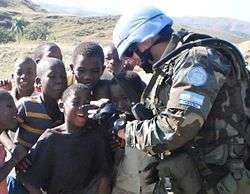
Since the return to civilian rule in 1983, the Argentine military have been reduced both in number and budget and, by law, cannot intervene anymore in internal civil conflicts. They became more professional, especially after conscription was abolished.
In 1998, Argentina was granted Major non-NATO ally status by the United States. The modern Argentine Army is fully committed to international peacekeeping under United Nations mandates, humanitarian aid and emergencies relief.
In 2010, the Army incorporated Chinese Norinco armored wheeled APCs to deploy with its peacekeeping forces.[36]
In 2016 President Mauricio Macri modified a decree made by the 1984 government of Raúl Alfonsín which had removed much of the military's autonomy.[37]
A major problem of today's Army is that most of its combat units are understrength in manpower due to budgetary limitations; the current Table of Organization and Equipment being established at a time during which the Army could rely on larger budgets and conscripted troops. Current plans call for the expansion of all combat units until all combat units are again full-strength, as soon as budget constraints allow for the induction of new volunteer service personnel of both genders.
Structure
Army General Staff
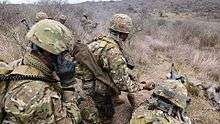
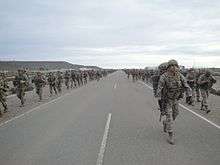
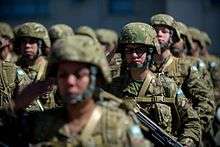
The Army is headed by a Chief of General Staff directly appointed by the President. The current Chief of the General Staff (since September 2008) is General Luis Alberto Pozzi.[38] The General Staff of the Army (Estado Mayor General del Ejército) includes the Chief of Staff, a Deputy Chief of the General Staff and the heads of the General Staff's six departments (Jefaturas). The current departments of the General Staff (known also by their Roman numerals) are:
- Personnel (Jefatura I – Personal)
- Intelligence (Jefatura II – Inteligencia)
- Operations (Jefatura III – Operaciones)
- Logistic (Jefatura IV – Material)
- Finance (Jefatura V – Finanzas)
- Welfare (Jefatura VI – Bienestar)
The General Staff also includes the General Inspectorate and the General Secretariat.
There are also a number of Commands and Directorates responsible for development and implementation of policies within the Army regarding technological and operational areas. They also handle administrative affairs. As of 2005, these include the following:
- Communications and Computer Command (Comando de Comunicación e Informática)
- Education and Doctrine Command (Comando de Educación y Doctrina)
- Engineers Command (Comando de Ingenieros)
- Remount and Veterinary Command (Comando de Remonta y Veterinaria)
- Health Command (Comando de Sanidad)
- Materiel Logistics Command (Comando Logístico de Material)
- Army Historical Directorate (Dirección de Asuntos Históricos del Ejército)
- Research, Development and Production Directorate (Dirección de Investigación, Desarrollo y Producción)
- Planning Directorate (Dirección de Planeamiento)
- Transportation Directorate (Dirección de Transporte)
- General Staff Directorate (Dirección del Estado Mayor General del Ejército)
Field organization
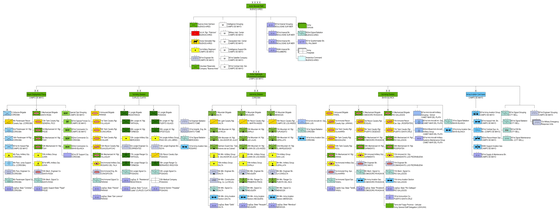
In the 1960s, the Army was reorganised into five Army Corps. This structure replaced the old structure based on divisions following the French model. There was a further reorganisation in 1991, when brigades were assigned to six new divisions, two stationed at Santa Cruz and Mendoza.[39]
Until late 2010, the First, Second and Third Army Divisions were designated as the Second, Third and Fifth Army Corps (Cuerpos de Ejército) respectively, without any intermediate division-level commands. These redesignations took place as part of a major reorganization of the Armed Forces' administrative and command structure. Two additional Army Corps, the First and Fourth, had already been dissolved in 1984 and 1991 respectively, with their dependent units reassigned to the remaining three Army Corps.
As of 2011, army forces are geographically grouped into three Army Divisions (Divisiones de Ejército), each roughly equivalent in terms of nominal organization to a U.S. Army division (+). Each Army Division has an area of responsibility over a specific region of the country; First Army Division covers the northeast of the country, Second Army Division covers the center and northwest of Argentina and Third Army Division covers the south and Patagonia. In addition to the three Army Divisions, the Rapid Deployment Force (Fuerza de Despliegue Rápido, FDR) forms an additional fourth divisional-level formation, while the Buenos Aires Military Garrison operates independently from any division-sized command. There are also several separate groups, including an anti-aircraft group and the Argentine Army Aviation group.
Each division has varying numbers of brigades of armor, mechanized forces and infantry.
As of 2011, the Argentine Army has eleven brigades:
- two armored brigades (1st and 2nd),
- three mechanized brigades (9th, 10th and 11th),
- three mountain brigades (5th, 6th and 8th),
- one paratrooper brigade (4th) and
- two jungle brigades (3rd and 12th).
Note: The 7th Infantry Brigade was dissolved in early 1985, while the 3rd Infantry Brigade was converted into a motorized training formation, which was ultimately dissolved in 2003.
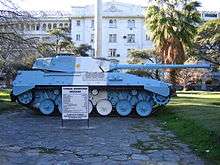
Depending on its type, each brigade includes two to five Cavalry or Infantry Regiments, one or two Artillery Groups, a scout cavalry squadron, one battalion or company-sized engineer unit, one intelligence company, one communications company, one command company and a battalion-sized logistical support unit. The terms "regiment" and "group", found in the official designations of cavalry, infantry and artillery units, are used due to historical reasons. During the Argentine War of Independence, the Argentine Army fielded traditional regiment-sized units. 'Regiments' are more accurately described as battalions; similar-sized units that do not belong to the above-mentioned services are referred to as "battalions". In addition to their service, Regiments and Groups are also specialized according to their area of operations (Mountain Infantry, Jungle Infantry, Mountain Cavalry), their equipment (Tank Cavalry, Light Cavalry, Mechanized Infantry) or their special training (Paratroopers, Commandos, Air Assault, Mountain Cazadores or Jungle Cazadores). Regiments are made up by four maneuver sub-units (companies in infantry regiments and squadrons in cavalry regiments) and one command and support sub-unit for a total of 350 to 700 troops.
In 2006, a Rapid Deployment Force was created based on the 4th Paratrooper Brigade.
In 2008, a Special Operations Forces Group was created comprising two Commando Companies, one Special Forces Company and one psychological operations company.
Current equipment of the Argentine Army
See also: Equipment of the Argentine Army
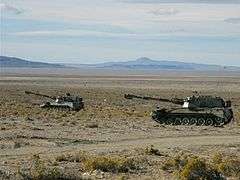 Two TAM VCA in exercise.
Two TAM VCA in exercise.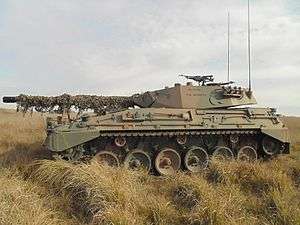 Medium Argentine Tank.
Medium Argentine Tank.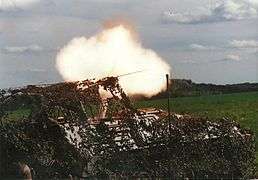 Self-propelled mortar VCTM opening fire.
Self-propelled mortar VCTM opening fire.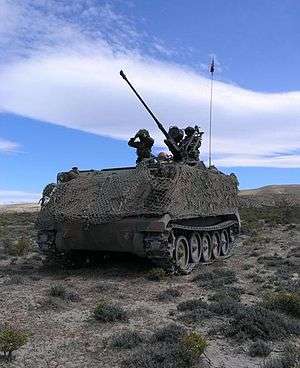 Argentine M-113 equipped with AA cannon.
Argentine M-113 equipped with AA cannon.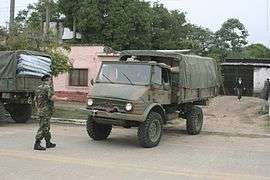 Unimog truck of the Argentine Army.
Unimog truck of the Argentine Army.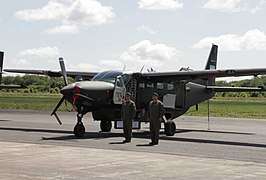 A Cessna 208B Grand Caravan EX from the Argentine Army
A Cessna 208B Grand Caravan EX from the Argentine Army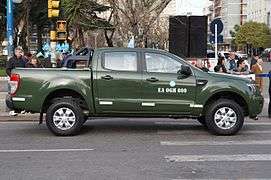 Ford Ranger the Argentine Army
Ford Ranger the Argentine Army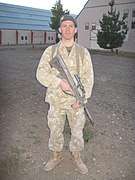 Argentine soldier carrying a Steyr AUG rifle
Argentine soldier carrying a Steyr AUG rifle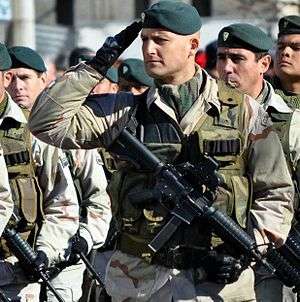 Argentine paratrooper carrying a Colt 9mm SMG
Argentine paratrooper carrying a Colt 9mm SMG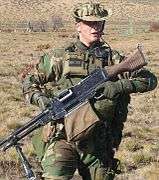 Member of the Squadron of Exploration of Cavalry 4 of the Argentine Army carrying a FN MAG machine gun
Member of the Squadron of Exploration of Cavalry 4 of the Argentine Army carrying a FN MAG machine gun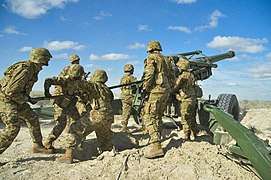 Argentine soldiers firing a CITER L33 155 mm howitzer
Argentine soldiers firing a CITER L33 155 mm howitzer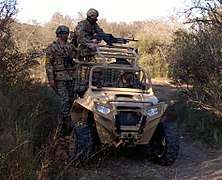 Polaris MRZR-4 vehicle during an exercise in 2016
Polaris MRZR-4 vehicle during an exercise in 2016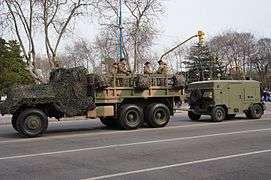 REO M35 truck
REO M35 truck.jpg) Bell UH-Huey of the Argentine Army
Bell UH-Huey of the Argentine Army
Ranks
Insignia for all ranks except Volunteers is worn on shoulder boards. Ranks from Colonel Major onwards use red-trimmed shoulderboards and the suns denoting rank are gold-braid; the suns on other officers' shoulder boards are metallic. Generals also wear golden wreath leaves on their coat lapels.
The rank insignia for Volunteers 1st Class, 2nd Class and Commissioned 2nd Class is worn on the sleeves. Collar versions of the ranks are used in combat uniforms.
The highest army rank in use is lieutenant-general. A higher army rank, captain-general, was awarded twice in the nineteenth century: to José de San Martín and to Bernardino Rivadavia. As a promotion to this rank is not foreseen, no insignia for the rank currently exists.
Officers
| Equivalent NATO Code | OF-10 | OF-9 | OF-8 | OF-7 | OF-6 | OF-5 | OF-4 | OF-3 | OF-2 | OF-1 | OF(D) & Student officer | |||||||||||||||||||||||||
|---|---|---|---|---|---|---|---|---|---|---|---|---|---|---|---|---|---|---|---|---|---|---|---|---|---|---|---|---|---|---|---|---|---|---|---|---|
(Edit) |
No equivalent |  |
 |
 |
 |
 |
 |
 |
 |
 |
 |
.svg.png) | ||||||||||||||||||||||||
| Teniente General | General de División | General de Brigada | Coronel Mayor | Coronel | Teniente Coronel | Mayor | Capitán | Teniente Primero | Teniente | Subteniente | ||||||||||||||||||||||||||
The rank of coronel mayor (senior colonel) is an honorary distinction for colonels occupying general's positions (such as brigade commander), but who are not senior enough to be promoted.[40]
NCOs and enlisted
| Equivalent NATO code | OR-9 | OR-8 | OR-7 | OR-6 | OR-5 | OR-4 | OR-3 | OR-2 | OR-1 | |||||||||||||||||||||||||||
|---|---|---|---|---|---|---|---|---|---|---|---|---|---|---|---|---|---|---|---|---|---|---|---|---|---|---|---|---|---|---|---|---|---|---|---|---|
(Edit) |
 |
 |
 |
 |
 |
 |
 |
 |
 |
 | ||||||||||||||||||||||||||
| Suboficial Mayor | Suboficial Principal | Sargento Ayudante | Sargento Primero | Sargento | Cabo Primero | Cabo | Voluntario Primero | Voluntario Segundo | Soldado de Segunda en Comisión | |||||||||||||||||||||||||||
See also
- Argentine Navy
- Argentine Air Force
- Argentine Naval Aviation
- Argentine Army Aviation
- Equipment of the Argentine Army
References
Citations
- Hugo Moreno, Le désastre argentin. Péronisme, politique et violence sociale (1930–2001), Editions Syllepses, Paris, 2005, p.109 (in French)
- "Buenos Aires News – Argentina reveals secrets of 'dirty war'". Archived from the original on 14 May 2013. Retrieved 24 December 2014.
- Paul H. Lewis, Guerrillas & Generals: The "Dirty War" in Argentina, Praeger Paperback, 2001, p. 126.
- John Keegan, World Armies|page=22, Macmillan, 1983
- TUCUMAN 1975: Avión del Ejército Argentino es derribado con ametralladoras antiaéreas Archived 2011-07-06 at the Wayback Machine
- [E]l commando general del Ejército procederá a ejecutar todas las operaciones militares que sean necesarias a efectos de neutralizar o aniquilar el accionar de los elementos subversivos que actúan en la provincia de Tucumán (in Spanish)
- Decree No. 261/75 Archived 2006-11-15 at the Wayback Machine. NuncaMas.org, Decretos de aniquilamiento.
- Facts on File, p. 126 (1975)
- English, Adrian J. Armed Forces of Latin America: Their Histories, Development, Present Strength, and Military Potential, Janes Information Group, 1984, p. 33
- Martha Crenshaw (1995). Terrorism in Context. p. 236. ISBN 978-0-271-01015-1.
- "The Montreal Gazette – Google News Archive Search". Retrieved 24 December 2014.
- "The Sydney Morning Herald – Google News Archive Search". Retrieved 24 December 2014.
- "monte chingolo guerrillas and generals – Google Search". Retrieved 24 December 2014.
- Troops fight off guerrillas, The Rock Hill Herald, 22 December 1975
- Monte Chingolo: Voces de Resistencia Archived 2009-11-30 at the Wayback Machine
- "ARGENTINA: Hanging from the Cliff". Time Magazine, Monday, 5 January 1976
- "The Windsor Star – Google News Archive Search". Retrieved 24 December 2014.
- "Argentine theatre hit by bomb" The Spokesman-Review 31 December 1975
- Conclusion of Marie-Monique Robin's Escadrons de la mort, l'école française (in French)
- MM. Giscard d'Estaing et Messmer pourraient être entendus sur l'aide aux dictatures sud-américaines, Le Monde, September 25, 2003 (in French)
- « Série B. Amérique 1952–1963. Sous-série : Argentine, n° 74. Cotes : 18.6.1. mars 52-août 63 ».
- RAPPORT FAIT AU NOM DE LA COMMISSION DES AFFAIRES ÉTRANGÈRES SUR LA PROPOSITION DE RÉSOLUTION (n° 1060), tendant à la création d'une commission d'enquête sur le rôle de la France dans le soutien aux régimes militaires d'Amérique latine entre 1973 et 1984, PAR M. ROLAND BLUM, French National Assembly (in French)
- Argentine : M. de Villepin défend les firmes françaises, Le Monde, February 5, 2003 (in French)
- "Operación Rosario". Argentina.gob.ar. Argentine Ministry of Defence. Retrieved 8 June 2018.
- "Defensa de las islas". Argentina.gob.ar (in Spanish). Retrieved 8 June 2018.
- "Las primeras acciones terrestres en el Estrecho". Argentina.gob.ar (in Spanish). Retrieved 8 June 2018.
- "La gran batalla". Argentina.gob.ar (in Spanish). Retrieved 8 June 2018.
- "Voladura del puente Fitz Roy". Argentina.gob.ar (in Spanish). Retrieved 8 June 2018.
- "Top Malo House". Argentina.gob.ar (in Spanish). Retrieved 8 June 2018.
- "Monte Longdon". Argentina.gob.ar (in Spanish). Retrieved 8 June 2018.
- "Monte Dos Hermanas". Argentina.gob.ar (in Spanish). Retrieved 8 June 2018.
- "Tumbledown". Argentina.gob.ar (in Spanish). Retrieved 8 June 2018.
- "Monte Harriet". Argentina.gob.ar (in Spanish). Retrieved 8 June 2018.
- "Sapper Hill". Argentina.gob.ar (in Spanish). Retrieved 8 June 2018.
- "Wireless Ridge". Argentina.gob.ar. Retrieved 8 June 2018.
- vehículos Norinco de reciente provisión
- Rivas Molina, Federico (June 3, 2016). "Mauricio Macri reduce el control civil sobre las Fuerzas Armadas". El País (in Spanish). Retrieved August 30, 2017.
- Nueva, La. "La Nueva". www.lanueva.com (in Spanish). Retrieved 2019-03-09.
- Jane's Defence Weekly 2 February 1991
- "Coronel Mayor y Comodoro de Marina" (PDF). Archived from the original (PDF) on 2016-09-10. Retrieved 2013-06-08.
Sources
- International Institute for Strategic Studies (2010-02-03). Hackett, James (ed.). The Military Balance 2010. London: Routledge. ISBN 1-85743-557-5.
Further reading
- Garcia Loperena, Gaston Javier (August 2016). El Unimog en el Ejercito Argentino (in Spanish) (1st ed.). 1884 Editorial – Buenos Aires (2015). ISBN 9789509822993. Archived from the original on 2017-01-22. Retrieved 2016-10-27.
- Garcia Loperena, Gaston Javier (March 2015). Vehiculos Tacticos del Ejercito Argentino (in Spanish) (1st ed.). 1884 Editorial – Buenos Aires (2014). ISBN 9789509822962. Archived from the original on 2017-01-22. Retrieved 2016-10-27.
External links
- (in Spanish) Official website
- (in Spanish) Organization and equipment
- Globalsecurity.org – Argentine Army – Equipment (page updated 05-02-2015) (accessed 2015-02-28)